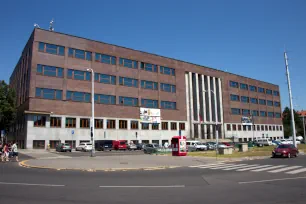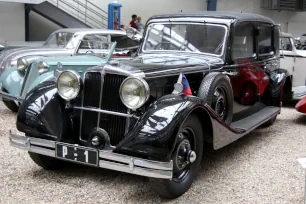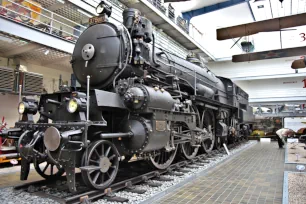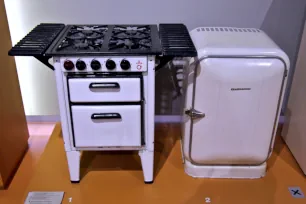The National Technical Museum ranks as one of the best museums of its kind in Europe. Its collection spans various fields, from mining and transportation to architecture and astronomical clocks.
Museum History

The National Technical Museum was founded in 1908 as the “Technical Museum of the Czech Kingdom”. It started exhibiting its collection – which it inherited from an engineering school and a polytechnical institute – two years later in the Schwarzenberg Palace at the palace square near the Prague Castle. Funds for a new building were acquired and construction started in 1938. When it was completed in 1941 the building was immediately commandeered by the occupying German forces, so the museum’s collection moved to the historic Invalidovna building in the Karlín district.
After the war the museum moved to its new location on Letná, in Holešovice, where it is still housed to this day. In 1951 the museum was nationalized and given its current name: the National Technical Museum. In the following decades its collection expanded rapidly, covering all sorts of areas from transportation and machines, over mining and geodesy to photography and astronomy.
The Building

Soon after its opening in the Schwarzenberg Palace, it was apparent that there was a need for a more suitable and modern building to house the collection of the technical museum. Already in 1921 fundraising started, and in 1925 land was purchased on Letná in Holešovice.
By 1930 it was apparent that the museum was not able to gather sufficient funds for its new building, so in 1931 the Technical Museum made an agreement with the well-funded Agricultural Museum to build a large “Museum of the Czechoslovak Work” to be shared equally by both museum institutions.
In 1935 a public architectural competition was organized for the construction of the new joint museum. A design by architect Milan Babuška was selected, and it seemed like nothing could stop the new joint project from being built. Unfortunately, the administration of the city of Prague threw a spanner in the works. They insisted that regulations called for two separate buildings with a road in between to ensure proper traffic circulation.
Eventually, both museums asked Milan Babuška to create a single building for each museum. The architect designed two almost identical buildings in a monumental, functional style. Construction started in 1938 and the building was finally completed in 1942.
Exhibitions


The museum presents its vast collection in 14 permanent exhibitions, spread across seven floors, including three underground. Its main strength is in transportation, but there are other fascinating exhibitions, like astronomy and time measurement.
Transportation
The main attraction of the museum is its extensive automotive collection, displayed in a large hall on the ground floor. Czechoslovakia has a rich manufacturing history which is proudly exhibited here: the oldest car on display is the very first Czech car ever built: the ‘Präsident’, a carriage-like car from 1898 built by Laurin & Klement, the precursor of Škoda Auto. Another automotive highlight is the Tatra 80, a Czech-made luxury automobile from 1935 that was used by the president of Czechoslovakia.
But there’s much more on display in the main hall than just vehicles: there are also all sorts of bicycles, motorcycles, giant locomotives, a hot-air balloon basket and airplanes, such as the French Blériot monoplane in which, in 1911, was flown by the Czech aviation pioneer Jan Kašpar on the first long-distance flight, covering 121 kilometers in about 92 minutes.
Astronomy

Another interesting exhibition is the collection of astronomical instruments on level 2. Here you find devices that were used in astronomy from the 15th to the 20th century. Prague was home to two of the most famous astronomers in history – Tycho Brahe and Johannes Kepler – and you can see some of the instruments they used here. The astronomy department also has a 5,000-year-old meteorite on display. On the corridor of the same floor, a special place is reserved for the large Van de Graaff generator, an electrostatic generator that produces very high voltage direct current (DC) electricity at low current levels.
Measurement of Time
More fascinating devices can be found in the exposition about the measurement of time, where you find sundials and all sorts of clocks, from water clocks to clocks based on quantum principles. You can also admire the tools they used to make clocks and watches.
More



The exhibit on printing on level 1 shows the technical evolution from the invention of printing to the present; on display are several large printing presses, including a manual book printing press from the 18th century and a massive printing machine from 1910.
On the same floor is an exhibit on technology in households, where you can see the type of appliances that were used in daily life, including some from during the Communist era.
The photography and film exhibit is also quite extensive. It traces the development of photography throughout time. A highlight is a 1839 Still-Life daguerreotype from the inventor himself, Louis Daguerre. And on the top floor you can even see a whole film studio from the 2000s.
On the top floor, you can find an exhibit on the history of architecture. You can see how bridges were constructed and what the features are of the various architectural styles that were prevalent in the Czech lands, such as Art Nouveau and Cubism.
On Level -2 children can play with Mercur, a popular metal construction set that was made in Czechoslovakia and exported around the world. The toy is still made to this day.
Finally, there are also exhibitions on Sugar and Chocolate – devoted to the Czech sugar industry- as well as exhibitions on chemistry, metallurgy and mining. The basement of the museum building even features a recreated coal mine that can be visited with a guide.

